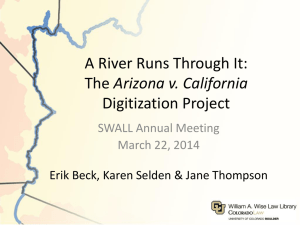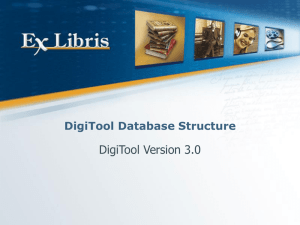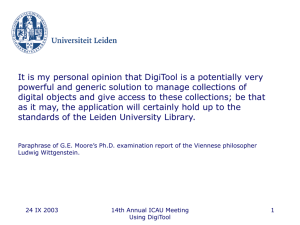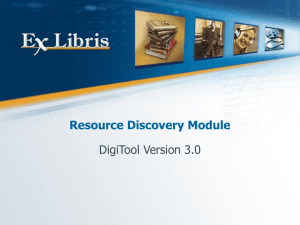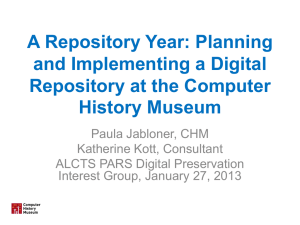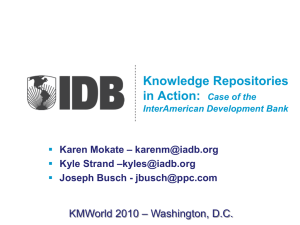DigiTool 3.0 - Introduction
advertisement
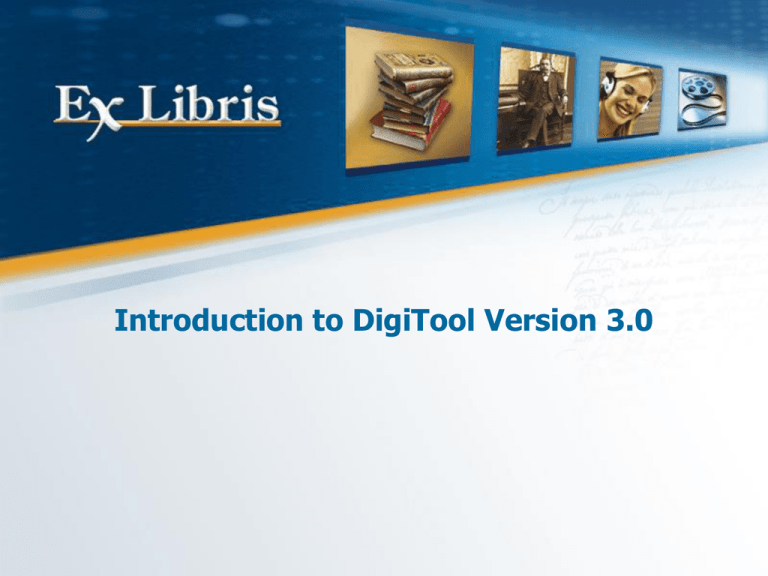
Introduction to DigiTool Version 3.0 About Version 3.0 DigiTool Repository DigiTool Deposit DigiTool Ingest DigiTool Metadata Editor (Meditor) DigiTool Resource Discovery DigiTool Collection Management Introduction to DigiTool Version 3.0 2 What is DigiTool? DigiTool is an enterprise solution for the management of digital assets in libraries and academic environments. Introduction to DigiTool Version 3.0 3 What is DigiTool? Modular, flexible, open architecture addresses current and future requirements of: Institutional Repositories Theses Research Papers Committee Reports Educational Materials Special Collections E-reserves, and Licensed Collections National Heritage Collections Introduction to DigiTool Version 3.0 4 What Does DigiTool Do? DigiTool enables institutions to create, manage, preserve, locally administered digital collections… Introduction to DigiTool Version 3.0 5 …and empowers end users in exploring the digital collections and accessing digital content. Introduction to DigiTool Version 3.0 6 DigiTool Modules Deposit Single & Bulk Search & Index Dispatcher & Viewers Approval Web Services Introduction to DigiTool Version 3.0 7 System Components – Technology J2EE AP Web-based Collection Management X-Server, OAI, Z39.50 J2EE AP Web-based Delivery Viewers J2EE AP Dispatcher Web-based Resource Discovery Metadata Editor PC Application Resource Discovery Server PC Server J2EE AP Web-based Ingest J2EE AP Web-based Deposit J2EE AP Indexes Oracle Indexer Repository Harvester Objects Storage Introduction to DigiTool Version 3.0 Metadata Oracle 8 About Version 3.0 DigiTool Repository DigiTool Deposit DigiTool Ingest DigiTool Metadata Editor DigiTool Resource Discovery DigiTool Collection Management Introduction to DigiTool Version 3.0 9 Repository Main characteristics: Responsible for storage and management of objects. Stand-alone component with a standard API (Web Services). File storage: local (NFS), remote (URL). Local storage is controlled by storage rules. Metadata storage in “XML boxes” based on the metadata type (e.g., descriptive, technical). Decomposition of compound objects (e.g., METS) to facilitate long term preservation. Introduction to DigiTool Version 3.0 10 Descriptive Metadata File stream Title: Spring Creator: Jones, John Subject: Scenery Subject: Flowers Subject: Seasons Description: Kids in a flowering field Administrative Metadata File name: spring981182.jpg File size: 780KB Technical Software environments File: type: Image Installation requirements Mime: Type: image/jpeg Access facilitators: Checksum: 9811821243567643 Process type: Migration Rights holder: Process purpose: Format obsolete Preservation Contact address: Permission type: Display Rights Introduction to DigiTool Version 3.0 11 Simple Object Representation OBJECT PID Persistent ID File Descriptive DC Descriptive MARC Technical NISO Preservation Metadata records can be shared between objects. Introduction to DigiTool Version 3.0 12 Metadata Linking – Detail Metadata is associated with a digital entity, but not exclusively. Multiple digital entities can “point” to the same metadata, on a metadata-by-metadata basis. PID 1001 PID 1002 MID 11 is shared by 2 Digital Entities PID 1001/1002 Introduction to DigiTool Version 3.0 MID 10 MID 11 MID 12 13 Storage Management Storage Rules determine to which Storage Group a certain object is directed. Storage rules can be based on ingest application, preservation level, administrative unit, file size, MIME type, or a combination of these elements. Storage Groups determine the storage type, i.e., location root and folder break. Storage Groups and Storage Rules are controlled by the repository administrator. Introduction to DigiTool Version 3.0 14 About Version 3.0 DigiTool Repository DigiTool Deposit DigiTool Ingest DigiTool Metadata Editor DigiTool Resource Discovery DigiTool Collection Management Introduction to DigiTool Version 3.0 15 Deposit Module Designed to support the acceptance of digital object deposits: of scholarly work from students/professors (e.g., theses, dissertations, etc.). of learning objects by instructors. of special collections by non- staff users (e.g., student, faculty members, outsource) as part of collection creation. Introduction to DigiTool Version 3.0 16 Deposit Module Consists of three main user interfaces: Deposit – serves depositors for the deposit of objects Approver – serves approvers for the review of the deposits Management – allows the configuration of the deposit workflow, depositor and approver profiles and groups Deposits are ingested into the Repository only after approval Ingest into the Repository can be: Automatic when a deposit is approved Via the Ingest module where pre ingest tasks can be further defined Introduction to DigiTool Version 3.0 17 Deposit Module – Main Features Status-driven deposit management Special deposit workflows (wizard) for different material types: Special descriptive forms for each material type Imposes submission rules per material type (i.e., up to a certain size, only certain formats) Manages depositor profiles Assigns material types to depositors Controls number of deposits Assigns depositor to approver Introduction to DigiTool Version 3.0 18 Depositor Interface Introduction to DigiTool Version 3.0 19 New Deposit Activity Introduction to DigiTool Version 3.0 20 About Version 3.0 DigiTool Repository DigiTool Deposit DigiTool Ingest DigiTool Metadata Editor DigiTool Resource Discovery DigiTool Collection Management Introduction to DigiTool Version 3.0 21 Ingest Module Two main functions: Creation and submission of new ingest activities – bulk and individual Monitoring of ingest status (scheduled, running success etc.) Ingest activities can be initiated directly from the Ingest application or by pre-defined for automatic ingest via the Deposit Module Introduction to DigiTool Version 3.0 22 Ingest Main Functions Introduction to DigiTool Version 3.0 23 Ingest Architecture One loader, multi transformers Transformer – take objects and/or metadata as input, and transform it to the Repository digital entity representation. Ingest activity is a workflow that combines a certain transforming process with pre-ingest tasks, and is followed by the generic loader. All loads (including batch) are processed as individual digital entities to control loading errors. Introduction to DigiTool Version 3.0 24 Ingest Activity A typical workflow for submission of Ingest activity: 1. Enter activity name and schedule time for running, select type of transformer and determine the background tasks to run as part of the ingest activity. 2. Order/Select background tasks into a task chain 3. Select Digital Entity template and select/verify background task parameters 4. Point to location of files or upload files 5. Submit Introduction to DigiTool Version 3.0 25 Ingest Activity – File upload Introduction to DigiTool Version 3.0 26 About Version 3.0 DigiTool Repository DigiTool Deposit DigiTool Ingest DigiTool Metadata Editor DigiTool Resource Discovery DigiTool Collection Management Introduction to DigiTool Version 3.0 27 Meditor - Metadata Editor The metadata editor in version 3.0 supports editing of the following metadata types: Descriptive Metadata MARC Dublin Core (Dublin XML) Technical metadata Image - NISO Z39.87 for still images (MIX) Text – textmd (NYU - METS-Extension) Audio - Audio Technical Metadata (LOC AMD) Video - Video Technical Metadata (LOC VMD) Preservation metadata – Based on PREMIS Object History metadata – Based on PREMIS Rights metadata (EXL) Ability to add local fields to all metadata types Introduction to DigiTool Version 3.0 28 Metadata Editor — Main Features A client application that provides tools for the effective management of metadata: Templates (local and server) Tag-information Controlling rights (ownership) to the level of metadata type Controlling editing rights and record editing history Allows viewing of object while cataloging Allows browsing between objects, based on relationships Introduction to DigiTool Version 3.0 29 Metadata Editor: Screen Layout Introduction to DigiTool Version 3.0 30 About Version 3.0 DigiTool Repository DigiTool Deposit DigiTool Ingest DigiTool Metadata Editor DigiTool Resource Discovery DigiTool Collection Management Introduction to DigiTool Version 3.0 31 Resource Discovery – Main Features Collection Management and Personal Collections The new delivery system with four new viewers Flexible indexes that allow: Inclusion of objects with different descriptive formats (e.g., MARC, DC) in the same index. Creation of one index for objects owned by different administrative units (i.e., Union Catalog). Recomposition of compound objects (all manifestations or all pages of a book joined in one result). Introduction to DigiTool Version 3.0 32 Resource Discovery Interface Search Persistent Toolbar Collection Exploration Introduction to DigiTool Version 3.0 33 Resource Discovery: Main Components • Simple Search: search functionality targeted for novice users • Advanced Search: search functionality targeted for more experienced users • Collection exploration • Object Viewing • User Registration • My Space: management of personal data Introduction to DigiTool Version 3.0 34 Simple Search Options The Simple Search is the most basic form of searching DigiTool, carried out as a word search in all fields of the resource. There are several possible ways to conduct a simple search: Introduction to DigiTool Version 3.0 35 Advanced Search Options An array of options to perform complex keyword searches. Search of several indexes simultaneously, indicating terms relations by Boolean operators and limiting a search by media type or file format. Search in XML tags. Introduction to DigiTool Version 3.0 36 Manifestations The manifestation list is available from the brief view search results screen by clicking the thumbnail (or ellipsis) and from the full view search results screen. Introduction to DigiTool Version 3.0 37 Delivery DigiTool provides out-of-the-box viewers for: Single objects Multi-page objects (METS) EAD objects e-Shelf viewer Text viewer Introduction to DigiTool Version 3.0 38 Viewing Objects Side by Side Introduction to DigiTool Version 3.0 39 Viewing Compound Objects - METS Introduction to DigiTool Version 3.0 40 Viewing Compound Objects – EAD Introduction to DigiTool Version 3.0 41 Personal Collection Designed to support instructional/educational activities. Approved users, such as professors or instructors, can load objects in their e-Shelf and arrange them in a folder structure, together with objects from the main repository. Users can share their personal collections with other users (e.g., students) by publishing the collection and receiving a unique URL. Shared collection can be linked via a simple URL, and easily embedded in CMS/VLE systems. Introduction to DigiTool Version 3.0 42 About Version 3.0 DigiTool Repository DigiTool Deposit DigiTool Ingest DigiTool Metadata Editor DigiTool Resource Discovery DigiTool Collection Management Introduction to DigiTool Version 3.0 43 Collection Management Module The institution can arrange objects in a hierarchical collection structure. Staff members use a dedicated web-based interface for creation, management, and publishing of collections. A collection record can point either to a child collection of records (e.g., Art, Paintings) or can include pointers to specific objects or group of objects. Each collection record can include title, description, and thumbnail. Each object can be part of more than one collection. Introduction to DigiTool Version 3.0 44 Logical vs. Itemized A collection can be defined with a search command (i.e., logical) or a list of Object PID’s (itemized) A logical collection demands “instantiating” the search command to derive an actual list of objects The end result of the 2 collection types is a list of records, defined under Collection Management by search query or a list of Object PIDs. Introduction to DigiTool Version 3.0 45 Collection Management User Interface Introduction to DigiTool Version 3.0 46 Collections in Results View Introduction to DigiTool Version 3.0 47 Navigating by Module http://hostname:port/main Introduction to DigiTool Version 3.0 48 Navigating by Module Meditor – Launch Bar Introduction to DigiTool Version 3.0 49 Databases/Units in DigiTool Three types of units exist: 1. Admin Unit is a database that controls the work activity of cataloging, deposit, ingest, etc. for that specific unit only. e.g. DTL01, DTL02 2. Silo Unit is a database that holds the data and configuration for the Web-based Resource Discovery e.g. GEN01 3. System Unit is a database that controls systemrelated activities such as users, repository, storage and cache e.g. DAT01, REP00, EXT01, VIR01 Introduction to DigiTool Version 3.0 50 Support for Multi-Administrative Units It is a single institutional repository for consortia or multi-branch academic institutions. Each unit manages and controls its collections within the common repository. Patrons search all of the collections via a single resource-discovery interface. Introduction to DigiTool Version 3.0 51 Thank you! www.exlibrisgroup.com Introduction to DigiTool Version 3.0 52
